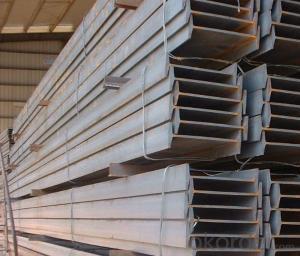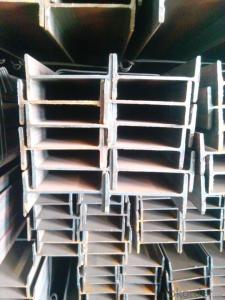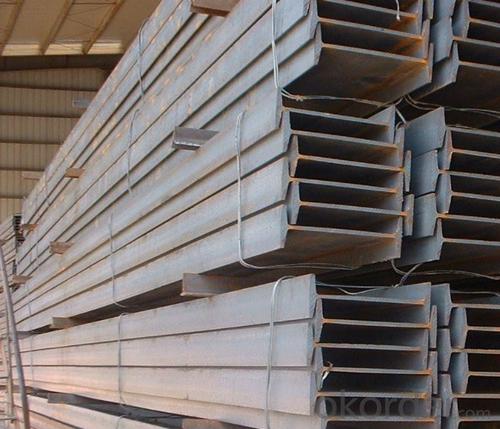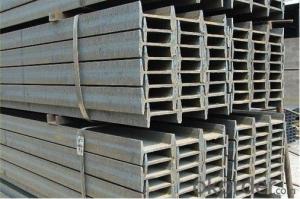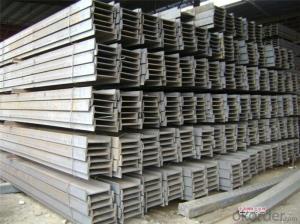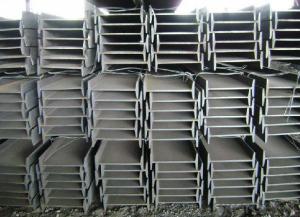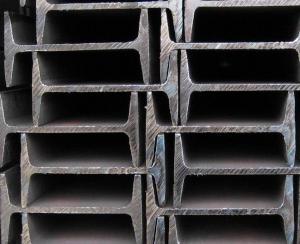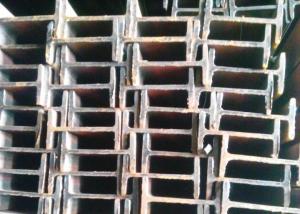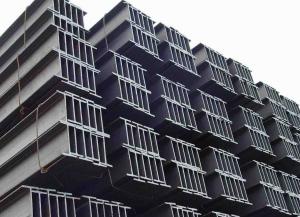Hot Rolled IPE and IPEAA Beam in Q235B Material Grade
- Loading Port:
- Tianjin
- Payment Terms:
- TT OR LC
- Min Order Qty:
- 25 m.t.
- Supply Capability:
- 10000 m.t./month
OKorder Service Pledge
OKorder Financial Service
You Might Also Like
Product Description:
OKorder is offering high quality Hot Rolled Steel I-Beams at great prices with worldwide shipping. Our supplier is a world-class manufacturer of steel, with our products utilized the world over. OKorder annually supplies products to European, North American and Asian markets. We provide quotations within 24 hours of receiving an inquiry and guarantee competitive prices.
Product Applications:
Hot Rolled Steel I-Beams are ideal for structural applications and are widely used in the construction of buildings and bridges, and the manufacturing, petrochemical, and transportation industries.
Product Advantages:
OKorder's Steel I-Beams are durable, strong, and resist corrosion.
Main Product Features:
· Premium quality
· Prompt delivery & seaworthy packing (30 days after receiving deposit)
· Corrosion resistance
· Can be recycled and reused
· Mill test certification
· Professional Service
· Competitive pricing
Product Specifications:
Manufacture: Hot rolled
Grade: Q195 – 235
Certificates: ISO, SGS, BV, CIQ
Length: 6m – 12m, as per customer request
Packaging: Export packing, nude packing, bundled
Chinese Standard (H*W*T) | Weight (Kg/m) | 6m (pcs/ton) | Light I (H*W*T) | Weight (Kg/m) | 6m (pcs/ton) | Light II (H*W*T) | Weight (Kg/m) | 6M |
100*68*4.5 | 11.261 | 14.8 | 100*66*4.3 | 10.13 | 16.4 | 100*64*4 | 8.45 | 19.7 |
120*74*5.0 | 13.987 | 11.9 | 120*72*4.8 | 12.59 | 13.2 | 120*70*4.5 | 10.49 | 15.8 |
140*80*5.5 | 16.89 | 9.8 | 140*78*5.3 | 15.2 | 10.9 | 140*76*5 | 12.67 | 13.1 |
160*88*6 | 20.513 | 8.1 | 160*86*5.8 | 18.46 | 9 | 160*84*5.5 | 15.38 | 10.8 |
180*94*6.5 | 24.143 | 6.9 | 180*92*6.3 | 21.73 | 7.6 | 180*90*6 | 18.11 | 9.2 |
200*100*7 | 27.929 | 5.9 | 200*98*6.8 | 25.14 | 6.6 | 200*96*6.5 | 20.95 | 7.9 |
220*110*7.5 | 33.07 | 5 | 220*108*7.3 | 29.76 | 5.6 | 220*106*7 | 24.8 | 6.7 |
250*116*8 | 38.105 | 4.3 | 250*114*7.8 | 34.29 | 4.8 | 250*112*7.5 | 28.58 | 5.8 |
280*122*8.5 | 43.492 | 3.8 | 280*120*8.2 | 39.14 | 4.2 | 280*120*8 | 36.97 | 4.5 |
300*126*9 | 48.084 | 3.4 | 300*124*9.2 | 43.28 | 3.8 | 300*124*8.5 | 40.87 | 4 |
320*130*9.5 | 52.717 | 3.1 | 320*127*9.2 | 48.5 | 3.4 | |||
360*136*10 | 60.037 | 2.7 | 360*132*9.5 | 55.23 | 3 |
FAQ:
Q1: Why buy Materials & Equipment from OKorder.com?
A1: All products offered byOKorder.com are carefully selected from China's most reliable manufacturing enterprises. Through its ISO certifications, OKorder.com adheres to the highest standards and a commitment to supply chain safety and customer satisfaction.
Q2: What makes stainless steel stainless?
A2: Stainless steel must contain at least 10.5 % chromium. It is this element that reacts with the oxygen in the air to form a complex chrome-oxide surface layer that is invisible but strong enough to prevent further oxygen from "staining" (rusting) the surface. Higher levels of chromium and the addition of other alloying elements such as nickel and molybdenum enhance this surface layer and improve the corrosion resistance of the stainless material.
Q3: How soon we can delivery the goods ?
A3: We have a mill with 20000mts of capacity per month. We can delivery the goods within in one month ,as long as your order quantity less than 20000mts .
Images:
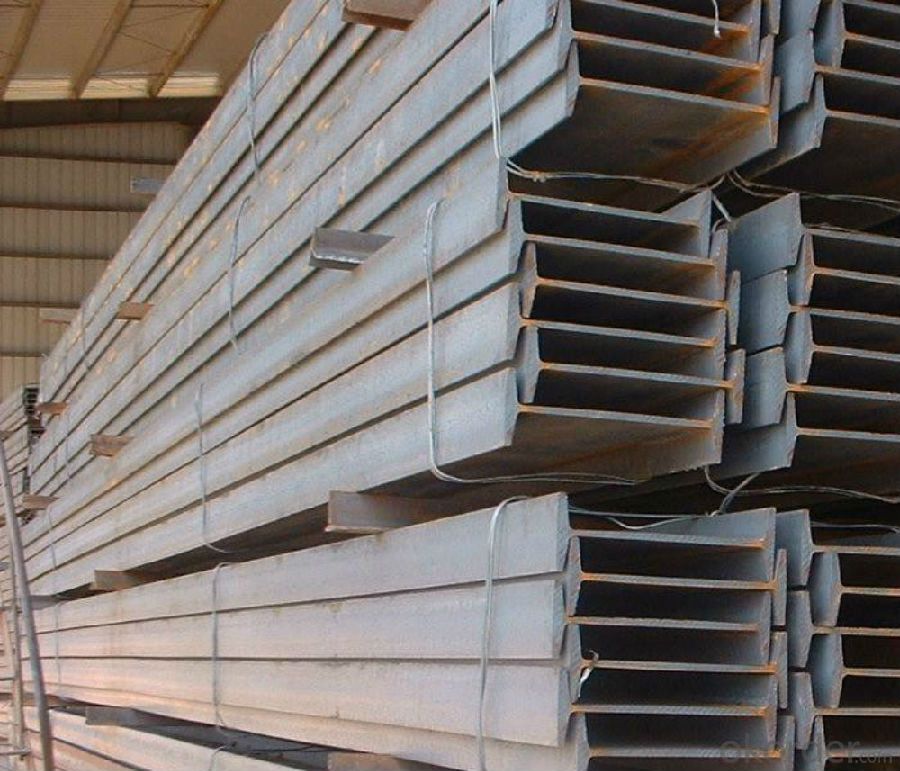
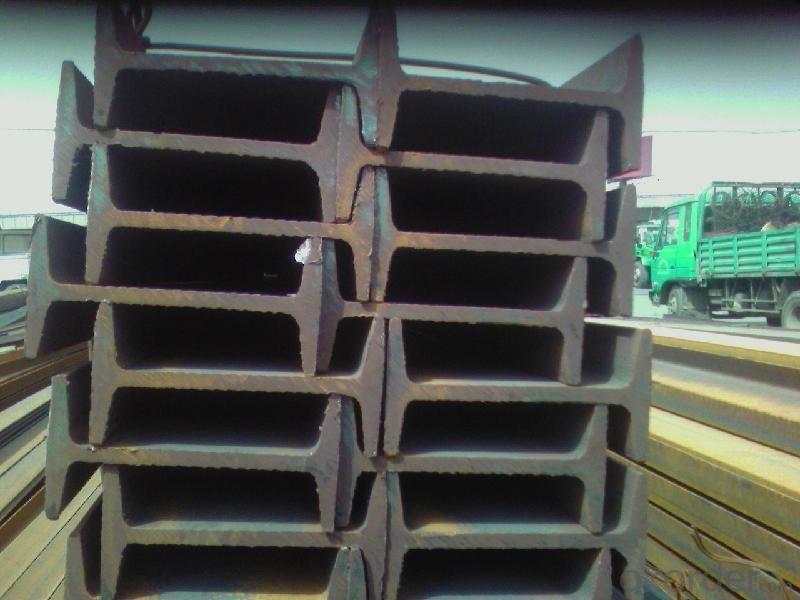
- Q: Are steel I-beams resistant to chemical exposure?
- Steel I-beams are generally resistant to chemical exposure. However, the level of resistance may vary depending on the specific chemical involved, its concentration, and the duration of exposure. It is important to consult with experts or refer to chemical compatibility charts to ensure proper protection and maintenance of steel I-beams in corrosive environments.
- Q: Can steel I-beams be used for elevated walkways?
- Indeed, elevated walkways can utilize steel I-beams. These I-beams are widely employed in construction due to their robustness and capacity to bear heavy loads. Their purpose is to uphold substantial weights, rendering them appropriate for erecting elevated walkways. By offering structural stability and durability, steel I-beams guarantee the safety of pedestrians traversing the walkway. Moreover, steel exhibits versatility as a material, enabling effortless fabrication into customized lengths and dimensions. This flexibility facilitates the creation of walkways tailored to meet precise specifications.
- Q: Are steel I-beams suitable for supporting rooftop swimming pools?
- Steel I-beams are indeed an appropriate choice for supporting rooftop swimming pools. These beams are widely used in construction due to their robustness and ability to bear heavy loads. They have been specifically designed to withstand substantial weight and offer exceptional structural support. In the case of rooftop swimming pools, the water, pool equipment, and additional features like decking and furniture can add up to a significant amount of weight. Steel I-beams are capable of evenly and effectively distributing this weight, thereby ensuring the stability and safety of the rooftop pool. Moreover, steel I-beams possess durability, resistance to corrosion, and the flexibility to be tailored to meet specific design requirements. Consequently, they represent a dependable and suitable option for supporting rooftop swimming pools.
- Q: What are the fire resistance properties of steel I-beams?
- Steel I-beams have excellent fire resistance properties. Due to their high melting point and ability to conduct heat away from the source, steel I-beams can withstand high temperatures for a significant period without structural failure. They do not burn or contribute to the spread of fire, making them a preferred choice in construction for fire-resistant applications.
- Q: What is the weight of a typical steel I-beam?
- The weight of a typical steel I-beam can vary depending on its size and dimensions. However, on average, a standard steel I-beam can weigh anywhere between 10 to 50 pounds per foot.
- Q: How do steel I-beams perform in terms of stiffness and rigidity?
- Steel I-beams are highly regarded for their exceptional stiffness and rigidity, making them the perfect choice for structural purposes. The distinctive construction of I-beams, featuring a vertical web that connects the top and bottom flanges, enables them to effectively distribute loads and withstand bending and deflection. In terms of stiffness, steel I-beams offer impressive resistance to deformation when subjected to applied loads. The vertical web acts as a solid support, preventing excessive sagging or bending of the beam. This stiffness guarantees that the beam maintains its shape and structural integrity, even under demanding loads or harsh environmental conditions. Rigidity, which refers to a material's ability to resist deformation or bending, is a key trait of steel I-beams. Their composition, including a combination of iron and carbon, endows them with high rigidity. This combination results in a strong and rigid material that can endure substantial forces without experiencing excessive deflection or deformation. Moreover, the shape of I-beams also contributes to their excellent stiffness and rigidity. The flanges situated at the top and bottom of the beam provide additional strength and resistance against bending moments. This design allows the I-beam to efficiently distribute loads and minimize deflection, thus making it suitable for applications that demand stable and rigid structures. In conclusion, steel I-beams are widely recognized for their remarkable stiffness and rigidity. Their unique shape and composition make them highly resistant to bending and deformation, enabling them to provide reliable support and structural integrity in various applications, including building construction, bridges, and industrial structures.
- Q: What are the common welding techniques used for steel I-beams?
- Steel I-beams can be welded using a variety of techniques, including shielded metal arc welding (SMAW), gas metal arc welding (GMAW), and flux-cored arc welding (FCAW). SMAW, also known as stick welding, involves manually welding with a consumable electrode coated in flux. The flux creates a protective shield that prevents contamination. It is a versatile technique that can be used in different positions and is commonly used for welding structural steel, including I-beams. GMAW, or MIG welding, is a semi-automatic process that uses a continuous solid wire electrode and a shielding gas. It offers fast welding speeds and precise control over the weld pool. GMAW is often preferred for welding steel I-beams due to its efficiency and ability to produce high-quality welds. FCAW is similar to GMAW, but it uses a hollow tubular electrode filled with flux. This eliminates the need for an external shielding gas, making it a cost-effective option. FCAW is commonly used for thicker steel I-beams or in outdoor environments where wind may affect the shielding gas. In some cases, specialized techniques like submerged arc welding (SAW) or laser beam welding (LBW) may be used for specific applications or in larger industrial settings. These techniques offer unique advantages such as higher deposition rates or precise control, but they are less commonly used in standard steel I-beam welding. Ultimately, the choice of welding technique depends on factors such as the thickness of the I-beam, desired weld quality, efficiency, and environmental conditions. Skilled welders and engineers can determine the most suitable technique based on these considerations to ensure strong and durable welds on steel I-beams.
- Q: How do steel I-beams contribute to the overall stability of a building?
- Steel I-beams contribute to the overall stability of a building in several ways. First and foremost, I-beams are renowned for their exceptional strength and load-bearing capacity. Due to their unique shape, I-beams are able to distribute the weight of the building evenly and efficiently, minimizing the risk of structural failure. The vertical web of the I-beam provides maximum resistance against bending and buckling, allowing it to support heavy loads and resist external forces such as wind or seismic activity. Moreover, the use of steel I-beams in construction allows for longer spans and greater open spaces within a building. This is because I-beams can support larger loads without the need for additional columns or supports. The ability to have larger uninterrupted floor areas enhances the flexibility and functionality of the building, allowing for various design possibilities and accommodating different uses. Steel I-beams also contribute to the overall stability of a building by providing structural rigidity. The inherent stiffness of steel, combined with the efficient design of the I-beam, helps to minimize deflection and sway in the building during dynamic events such as strong winds or earthquakes. This ensures that the building remains stable and can withstand external forces without compromising its structural integrity. Furthermore, steel I-beams are highly durable and resistant to corrosion, which is particularly important in areas with high humidity or exposure to harsh weather conditions. This durability ensures that the building's structural elements remain intact over time, reducing the risk of deterioration and ensuring long-term stability. In summary, steel I-beams contribute to the overall stability of a building through their exceptional strength, load-bearing capacity, and resistance to bending and buckling. They provide structural rigidity, allow for larger open spaces, and offer durability against corrosion. By incorporating steel I-beams into the construction process, buildings can achieve enhanced stability, safety, and longevity.
- Q: Are there any design considerations for incorporating steel I-beams in sustainable buildings?
- Several design considerations need to be taken into account when incorporating steel I-beams in sustainable buildings. One crucial factor is the utilization of recycled or reclaimed steel for I-beam production. By using recycled steel, the environmental impact of steel production can be significantly reduced, as it requires less energy and emits fewer greenhouse gases compared to the production of new steel. Another important consideration is the implementation of high-strength steel in I-beams, which enables the reduction of the overall amount of steel necessary for the building's structure. This not only decreases the building's environmental footprint but also lowers costs and construction time. Furthermore, the design of the I-beams should address their end-of-life cycle. Given that steel is highly recyclable, it is essential to ensure that the I-beams can be easily disassembled and recycled once they reach the end of their lifespan. This is crucial for sustainable building practices. Additionally, it is vital to optimize the structural efficiency of the I-beams through various techniques, including proper spacing, sizing, and orientation, as well as the utilization of advanced engineering software and analysis tools. This maximizes the load-bearing capacity of the I-beams, minimizing the overall amount of steel required for the building and thereby reducing environmental impacts. Lastly, the integration of steel I-beams with other sustainable building materials and systems should be considered. For instance, combining I-beams with energy-efficient insulation, renewable energy systems, and water-saving technologies further enhances the building's sustainability. To summarize, the incorporation of steel I-beams in sustainable buildings involves utilizing recycled or reclaimed steel, incorporating high-strength steel, optimizing structural efficiency, designing for end-of-life recyclability, and integrating with other sustainable building materials and systems. These considerations play a crucial role in minimizing environmental impact and maximizing overall sustainability.
- Q: What are the design considerations for steel I-beams in limited access areas?
- There are several key design considerations for steel I-beams in limited access areas. Firstly, the size and weight of the I-beams must be carefully determined to ensure they can be safely transported and maneuvered into the confined space. Additionally, the beams must be designed to withstand any potential loadings or forces that may be encountered during installation or use. The structural integrity of the surrounding area must also be evaluated to ensure it can support the weight of the beams. Finally, considerations must be made for any necessary modifications or adaptations to the beams to accommodate the restricted access, such as bolted connections or prefabricated sections.
Send your message to us
Hot Rolled IPE and IPEAA Beam in Q235B Material Grade
- Loading Port:
- Tianjin
- Payment Terms:
- TT OR LC
- Min Order Qty:
- 25 m.t.
- Supply Capability:
- 10000 m.t./month
OKorder Service Pledge
OKorder Financial Service
Similar products
Hot products
Hot Searches
Related keywords
